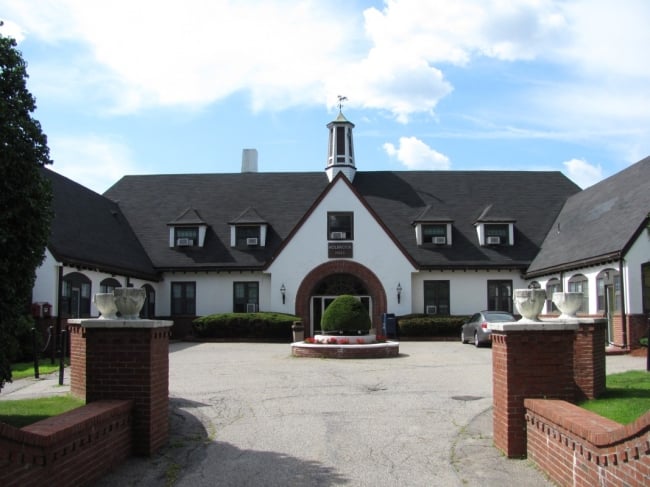You have /5 articles left.
Sign up for a free account or log in.

Mount Ida College
Wikimedia Commons
Tolstoy famously wrote that all happy families are alike, while each unhappy family is unhappy in its own way.
A new white paper suggests that the Tolstoy rule may not apply when it comes to at-risk small colleges: they’re all basically unhappy in the same way.
“Long-vulnerable” colleges tend to close or merge when a crisis pushes them “over the cliff,” writes Boston University political scientist Virginia Sapiro, who has studied the life cycles of colleges going back more than two centuries. Usually it’s debt that has become unsustainable to the institution or to its parent organization, such as a church or religious order.
Most colleges that fail are small, private and relatively nonselective, with “very particular or unusual missions” and graduation rates that are often as low as those at nonelite public universities, Sapiro said.
Practically speaking, high dependence on tuition -- as high as 80 to 90 percent -- is a good sign that an institution will not likely survive for long. “Tuition alone has never, that I know of, kept any college sustainable,” she said.
Closures are, of course, in the news more than ever. Several high-profile small private colleges have announced in recent months that they will close -- Vermont’s Green Mountain College said in January that it will close at the end of the spring semester, Newbury College in Brookline, Mass., announced in December that it would close at the end of this academic year and Atlantic Union College near Boston said it would close later this year. Hampshire College in Amherst, Mass., said last month that it won’t admit a freshman class this fall -- it’s looking for a strategic partner to continue operating but has also announced layoffs.
Moody's Investors Service last July said private college closures had risen to a rate of about 11 per year, with higher expected rates to come. The ratings agency made news in 2015, saying closures, then averaging five per year, could as much as triple by 2017, with mergers doubling. As of last summer, Moody's was still projecting a future increase in closures toward the range of 15 per year. It said a group of about 750 small private colleges is increasingly struggling to cover costs with revenue.
But Sapiro, who is writing a book about the history of higher ed in the U.S., said history shows that many private institutions are more robust than we suspect.
“Colleges and universities do not suddenly blow up,” she writes. “Even when they literally burn to the ground overnight -- as many have, sometimes more than once -- most find a means to carry on.”
Actually, she writes, if you look at U.S. higher ed from the very beginning of American history to 1889, for instance, you'll find that the “main building” of no fewer than 62 institutions (often it is the only building) burned to the ground. Then as now, college leaders, including trustees, faculty and other constituencies, have usually done “everything they can” to keep burned-down or other at-risk colleges alive -- even when enrollment numbers fell and debt became unmanageable.
The 2008 recession has heightened the significance of closures, since fewer new nonprofit institutions are arising than at nearly any time in history. That makes each closure matter more, since the total number of seats shrinks.
In the past, colleges have evolved slowly, often from tiny operations into regional and sometimes nationally recognized institutions. She noted, for instance, that the Anna Blake School, which opened in 1891 to offer training in economics and industrial arts, became the Santa Barbara State Normal School after the state of California took it over in 1909. Twelve years later it became Santa Barbara State College, then Santa Barbara College of the University of California. It's now known as UC Santa Barbara.
Likewise for the Pacific Sanitarium and School of Osteopathic Medicine, which opened in 1896. Long story short: it's now the UC Irvine School of Medicine.
Sapiro urges those who would predict hundreds of closures to consider that most colleges have spent “significant parts of their institutional existence teetering on the brink of ruin, deeply vulnerable to having to close.” A high proportion of colleges and universities have survived through troubled financial periods -- even back to Harvard University. Actually, institutions that we think of as elite have often been the beneficiaries of outside aid, either from donors, subscribers or even government largess. She noted that Harvard enjoyed “substantial public support” when it was founded in 1636. The Massachusetts Bay Colony donated the land for its campus and handed over revenues from a nearby toll bridge. “They had a whole bunch of public funds that served as the basis for their success later.”
She also noted that most of the U.S. colleges and universities with roots prior to the 20th century began as academies -- sometimes they began as primary schools, seminaries or even orphanages. That suggests the next great wave of colleges could evolve from very different-looking institutions.
While many observers these days would say that poorly run colleges deserve to close, Sapiro cautioned that a college is not like your typical business. For one thing, managers can't simply make its core product cheaper.
“We’re very confined,” she said. “We’re businesses, but we don’t run our institutions in the way of a for-profit business that buys and sells stuff.”
Colleges and universities that are under threat of closure “have a full range of bad choices to make,” she noted: they can lower standards, defer maintenance, create new programs to generate new students or cut unpopular programs that aren't attracting enough students. All of these, she suggested, are terrible ways to save money or bring in new revenue. A former dean, Sapiro said abolishing even an entire department “doesn’t save money the way you think it does.”
Colleges like Hampshire or Green Mountain, which have sought to provide a niche by focusing on sustainability and ecology, for instance, often find that this simply isn’t enough to differentiate themselves from others. “What Green Mountain found is that not every student who wants to be green and ecological is going to go there,” she said. “Some [students] are going to go to UCSD.”
In a few rare cases, colleges such as Boston University have intentionally planned for smaller entering freshman classes to be more selective -- in the process, she said, BU also increased acceptance of transfers with good records elsewhere (including at community colleges). That helped it become more desirable, while at the same time increasing access across different demographic groups, including first-generation students. “If you become an institution that is more prestigious, that can beat other institutions more at admissions, you win,” she said.
Sapiro also suggests critics pay closer attention to what she calls higher ed's “ecology” -- literally its cycle of birth, death and rebirth. When colleges die, they don’t simply disappear. Their physical assets, as well as their faculty, staff and students, often enrich another, sometimes related, college. “In some way or another, they feed the birth of another institution,” she said.
She noted that Wheelock College didn’t simply disappear in 2017 -- it merged into Boston University, bringing together two institutions with campuses separated by about a mile. The former college now houses the Boston University Wheelock College of Education & Human Development.
Struggling denominational colleges serve another interesting function, Sapiro said: when the religious institution that oversees one finally decides that it's unsustainable, it typically transfers funding to another educational undertaking that is sustainable, much as a holding company might do.
“It’s very sad when your alma mater or your institution goes down -- and it’s bad for the community because of all those business that depend on it," she said. "But very often it feeds the sustainability of another institution.”








